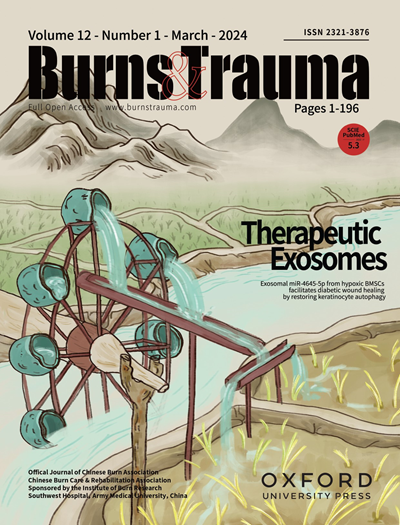多功能金属有机框架作为抗菌策略的有前途的纳米材料
IF 9.6
1区 医学
Q1 DERMATOLOGY
引用次数: 0
摘要
细菌感染对人类健康构成严重威胁。虽然抗生素在治疗细菌性传染病方面有效,但抗生素耐药性大大降低了它们的有效性。因此,开发新的有效的抗菌策略至关重要。金属有机骨架(mof)由于其晶体多孔结构、可调节的尺寸、良好的机械稳定性、大的表面积和化学稳定性,已成为各种抗菌应用的理想纳米材料。重要的是,mof的性能可以通过改变合成步骤和条件来调整。纯mof能释放金属离子,调节细胞行为,杀死多种微生物。此外,mof可以作为以所需方式递送抗菌剂的载体。重要的是,mof的性能可以通过改变合成步骤和条件来调整。此外,某些类型的mof可以与传统的光热或其他物理刺激相结合,以实现广谱抗菌活性。近年来,越来越多的研究人员对各种MOFs在细菌感染疾病中的应用进行了大量的研究。在此基础上,我们进行了这项研究,以报告基于mofs的抗菌策略的现状。此外,我们还讨论了mof目前在生物医学应用中面临的一些挑战,如生物相容性和控释能力。尽管这些挑战目前限制了它们的广泛应用,但我们相信,随着进一步的研究和开发,具有更高生物相容性和靶向能力的新型mof可以为各种细菌感染引起的疾病提供多样化的治疗策略。本文章由计算机程序翻译,如有差异,请以英文原文为准。
Multifunctional metal–organic frameworks as promising nanomaterials for antimicrobial strategies
Bacterial infections pose a serious threat to human health. While antibiotics have been effective in treating bacterial infectious diseases, antibiotic resistance significantly reduces their effectiveness. Therefore, it is crucial to develop new and effective antimicrobial strategies. Metal–organic frameworks (MOFs) have become ideal nanomaterials for various antimicrobial applications due to their crystalline porous structure, tunable size, good mechanical stability, large surface area, and chemical stability. Importantly, the performance of MOFs can be adjusted by changing the synthesis steps and conditions. Pure MOFs can release metal ions to modulate cellular behaviors and kill various microorganisms. Additionally, MOFs can act as carriers for delivering antimicrobial agents in a desired manner. Importantly, the performance of MOFs can be adjusted by changing the synthesis steps and conditions. Furthermore, certain types of MOFs can be combined with traditional photothermal or other physical stimuli to achieve broad-spectrum antimicrobial activity. Recently an increasing number of researchers have conducted many studies on applying various MOFs for diseases caused by bacterial infections. Based on this, we perform this study to report the current status of MOFs-based antimicrobial strategy. In addition, we also discussed some challenges that MOFs currently face in biomedical applications, such as biocompatibility and controlled release capabilities. Although these challenges currently limit their widespread use, we believe that with further research and development, new MOFs with higher biocompatibility and targeting capabilities can provide diversified treatment strategies for various diseases caused by bacterial infections.
求助全文
通过发布文献求助,成功后即可免费获取论文全文。
去求助
来源期刊

Burns & Trauma
医学-皮肤病学
CiteScore
8.40
自引率
9.40%
发文量
186
审稿时长
6 weeks
期刊介绍:
The first open access journal in the field of burns and trauma injury in the Asia-Pacific region, Burns & Trauma publishes the latest developments in basic, clinical and translational research in the field. With a special focus on prevention, clinical treatment and basic research, the journal welcomes submissions in various aspects of biomaterials, tissue engineering, stem cells, critical care, immunobiology, skin transplantation, and the prevention and regeneration of burns and trauma injuries. With an expert Editorial Board and a team of dedicated scientific editors, the journal enjoys a large readership and is supported by Southwest Hospital, which covers authors'' article processing charges.
 求助内容:
求助内容: 应助结果提醒方式:
应助结果提醒方式:


